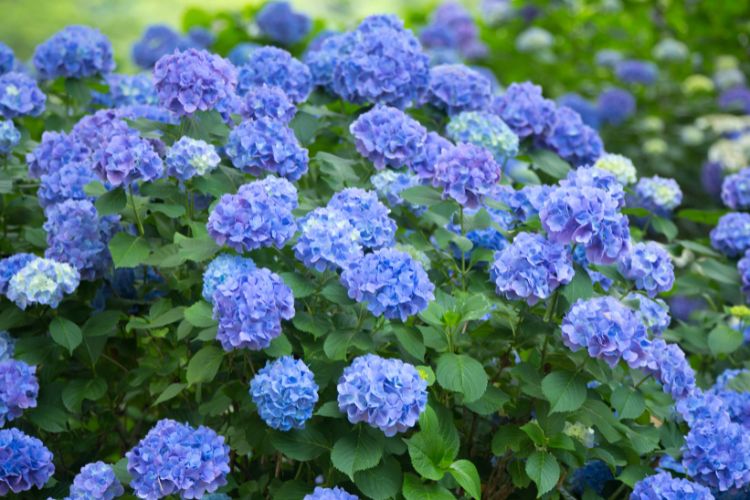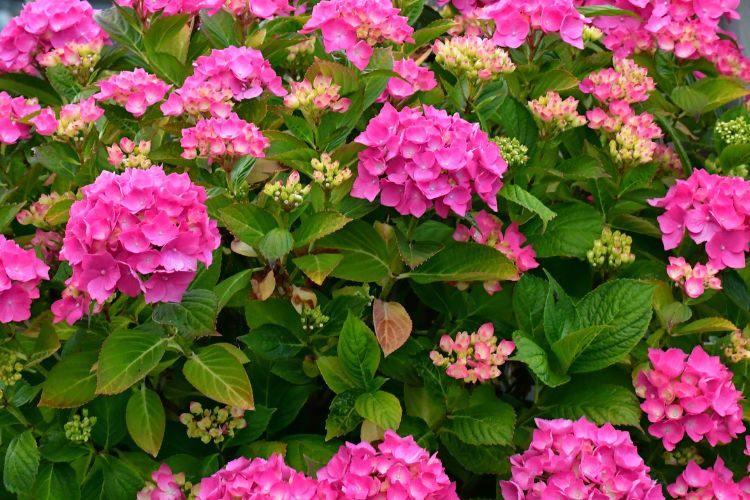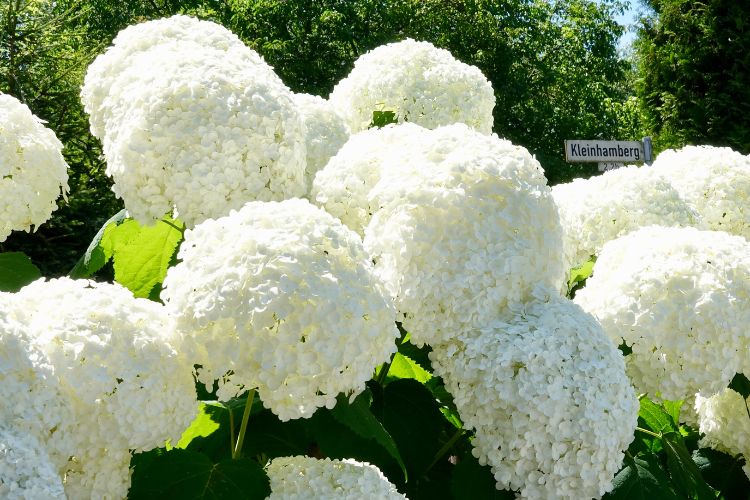Hydrangeas are a gardener’s dream, known for their stunning, globe-like flowers that can add a splash of color to any landscape.
One of the most fascinating aspects of hydrangeas is their ability to change bloom colors based on the soil’s pH level.
This natural color-changing phenomenon allows gardeners to experiment and personalize their garden’s look with just a few simple tricks.
In this comprehensive guide, we’ll reveal the secret to changing hydrangea bloom color and provide you with all the tips you need to achieve vibrant blue, pink, purple, or even white flowers.
Understanding Hydrangea Bloom Colors
Before diving into the steps to change your hydrangea’s bloom color, it’s essential to understand how soil pH affects the flowers. Hydrangea macrophylla, commonly known as bigleaf hydrangeas, are particularly sensitive to soil pH. Here’s how it works:
- Blue Blooms: Acidic soil (pH 5.5 or lower)
- Pink Blooms: Alkaline soil (pH 6.0 or higher)
- Purple Blooms: Intermediate pH levels (between 5.5 and 6.0)
- White Blooms: Typically, white hydrangeas (such as Hydrangea arborescens and Hydrangea paniculata) do not change color based on soil pH and remain white regardless of the soil’s acidity.
With this knowledge, you can tailor your soil conditions to produce the bloom colors you desire.
Achieving Blue Hydrangea Blooms

Blue hydrangea blooms are breathtaking and can create a serene, cool-toned garden space. To achieve this color, you need to make your soil more acidic. Here’s the simple trick to turn your hydrangeas blue:
Steps to Turn Hydrangeas Blue
- Test Your Soil pH:
- Before making any changes, use a soil pH test kit to determine the current pH level of your soil. For blue blooms, aim for a pH of 5.5 or lower.
- Add Soil Amendments:
- Aluminum Sulfate: This is the most effective amendment for lowering soil pH. Follow the instructions on the packaging for application rates. Generally, mix about 1 tablespoon of aluminum sulfate with a gallon of water and apply it to the soil around the hydrangea’s base. Repeat this process every 4-6 weeks during the growing season.
- Sulfur: Another option is elemental sulfur. Apply 1 cup of sulfur per 10 square feet of soil and mix it into the top few inches. Water thoroughly after application.
- Use Acidic Mulch:
- Mulching with materials such as pine needles, pine bark, or oak leaves can help maintain soil acidity over time. Spread a 2-3 inch layer around the base of the plants.
- Regular Watering:
- Hydrangeas prefer consistently moist soil. Water deeply and regularly, especially during dry periods, to keep the soil evenly moist and the acidity stable.
Maintenance for Blue Blooms
To maintain the blue color, regularly monitor your soil’s pH and reapply aluminum sulfate or sulfur as needed. Annual soil testing will help you keep the pH within the desired range.
Achieving Pink Hydrangea Blooms

If you prefer pretty pink hydrangea flowers, you need to make your soil more alkaline. Here’s the simple trick to encourage pink blooms:
Steps to Turn Hydrangeas Pink
- Test Your Soil pH:
- Use a soil pH test kit to determine the current pH level of your soil. For pink blooms, aim for a pH of 6.0 or higher.
- Add Soil Amendments:
- Garden Lime: This is the most common amendment for raising soil pH. Apply lime according to the packaging instructions, typically around 1 cup per 10 square feet of soil. Mix it into the top few inches of soil and water thoroughly.
- Wood Ash: Wood ash can also raise soil pH. Sprinkle it lightly around the base of the hydrangea and water it in well.
- Use Alkaline Mulch:
- Mulching with materials such as composted manure or mushroom compost can help maintain a higher soil pH over time. Spread a 2-3 inch layer around the plants.
- Regular Watering:
- Ensure your hydrangeas receive consistent moisture. Watering helps incorporate lime or wood ash into the soil, promoting alkalinity.
Maintenance for Pink Blooms
To maintain pink blooms, regularly check your soil’s pH and adjust as necessary. Adding garden lime or wood ash each year will help keep the soil alkaline and your hydrangeas beautifully pink.
Achieving Purple Hydrangea Blooms

Purple hydrangea blooms are stunning and can be achieved by maintaining an intermediate soil pH. Here’s the trick to get those lovely purple flowers:
Steps to Turn Hydrangeas Purple
- Test Your Soil pH:
- Determine your soil’s current pH level. For purple blooms, aim for a pH between 5.5 and 6.0.
- Balance Soil Amendments:
- If your soil is too acidic (below 5.5), add a small amount of garden lime to raise the pH slightly.
- If your soil is too alkaline (above 6.0), add a small amount of aluminum sulfate or sulfur to lower the pH slightly.
- Use Balanced Mulch:
- Use neutral or balanced mulch materials like composted leaves or grass clippings to help maintain the intermediate pH level.
- Consistent Watering:
- Water your hydrangeas regularly to keep the soil moist and maintain the balanced pH level.
Maintenance for Purple Blooms
Regular soil testing and adjustments are crucial for maintaining purple blooms. By carefully balancing your soil’s pH, you can enjoy the captivating sight of purple hydrangeas in your garden.
Maintaining White Hydrangea Blooms

White hydrangeas are classic and elegant, and unlike other hydrangea colors, they do not change based on soil pH. Here’s how to care for white hydrangeas to keep them looking their best:
Steps to Care for White Hydrangeas
- Choose the Right Variety:
- Select white hydrangea varieties such as Hydrangea arborescens (‘Annabelle’) or Hydrangea paniculata (‘Limelight’).
- Provide Ideal Growing Conditions:
- Plant white hydrangeas in well-draining soil with plenty of organic matter.
- Ensure they receive the appropriate amount of sunlight. Most white hydrangeas prefer morning sun and afternoon shade.
- Regular Watering:
- Keep the soil consistently moist but not waterlogged. White hydrangeas, like their colorful counterparts, prefer regular watering.
- Pruning and Fertilizing:
- Prune white hydrangeas as needed to maintain shape and remove dead or damaged stems.
- Use a balanced fertilizer to promote healthy growth and abundant blooms.
Maintenance for White Blooms
While white hydrangeas don’t require pH adjustments, they still need regular care to thrive. Provide them with the right growing conditions, and they will reward you with their pristine blooms year after year.
Tips for Successful Hydrangea Color Change

Changing hydrangea bloom color is a fun and rewarding process. Here are some additional tips to ensure success:
1. Be Patient
Changing the color of hydrangea blooms can take time. It may take several months to see significant changes, so be patient and persistent with your soil adjustments.
2. Monitor Soil pH Regularly
Regular soil testing is essential to maintaining the desired bloom color. Check your soil’s pH at least once a year and make adjustments as needed.
3. Avoid Over-Adjustment
When adding soil amendments, avoid over-adjusting the pH. Make gradual changes and test the soil frequently to ensure you don’t swing too far in one direction.
4. Know Your Hydrangea Type
Not all hydrangeas respond to soil pH changes. Make sure you are working with Hydrangea macrophylla (bigleaf hydrangeas) if you want to change bloom colors. Other types, like Hydrangea arborescens and Hydrangea paniculata, typically do not change color based on soil pH.
5. Experiment with Different Amendments
Different amendments can have varying effects on soil pH. If one method isn’t giving you the desired results, try another. For example, if aluminum sulfate isn’t working as well as you hoped, try using sulfur or garden lime.
6. Consider Environmental Factors
Environmental factors such as rainfall, temperature, and soil composition can influence your hydrangea’s color. Be mindful of these factors and adjust your care routine accordingly.
7. Enjoy the Process
Changing hydrangea bloom color is an enjoyable and creative aspect of gardening. Have fun experimenting with different colors and watching your garden transform over time.
If you want to see how to change hydrangea color in video, I suggest you watch Kelly’s video below:
Conclusion
Hydrangeas are versatile and stunning plants that can enhance any garden with their colorful blooms.
By understanding the science behind hydrangea bloom color and using simple soil amendments, you can create a personalized and vibrant garden.
Whether you prefer blue, pink, purple, or white blooms, the key lies in adjusting the soil pH and providing consistent care.
With patience and attention, you can unlock the secret to changing hydrangea bloom color and enjoy a beautiful and dynamic garden year after year. So, grab your soil pH test kit, choose your desired color, and start transforming your
